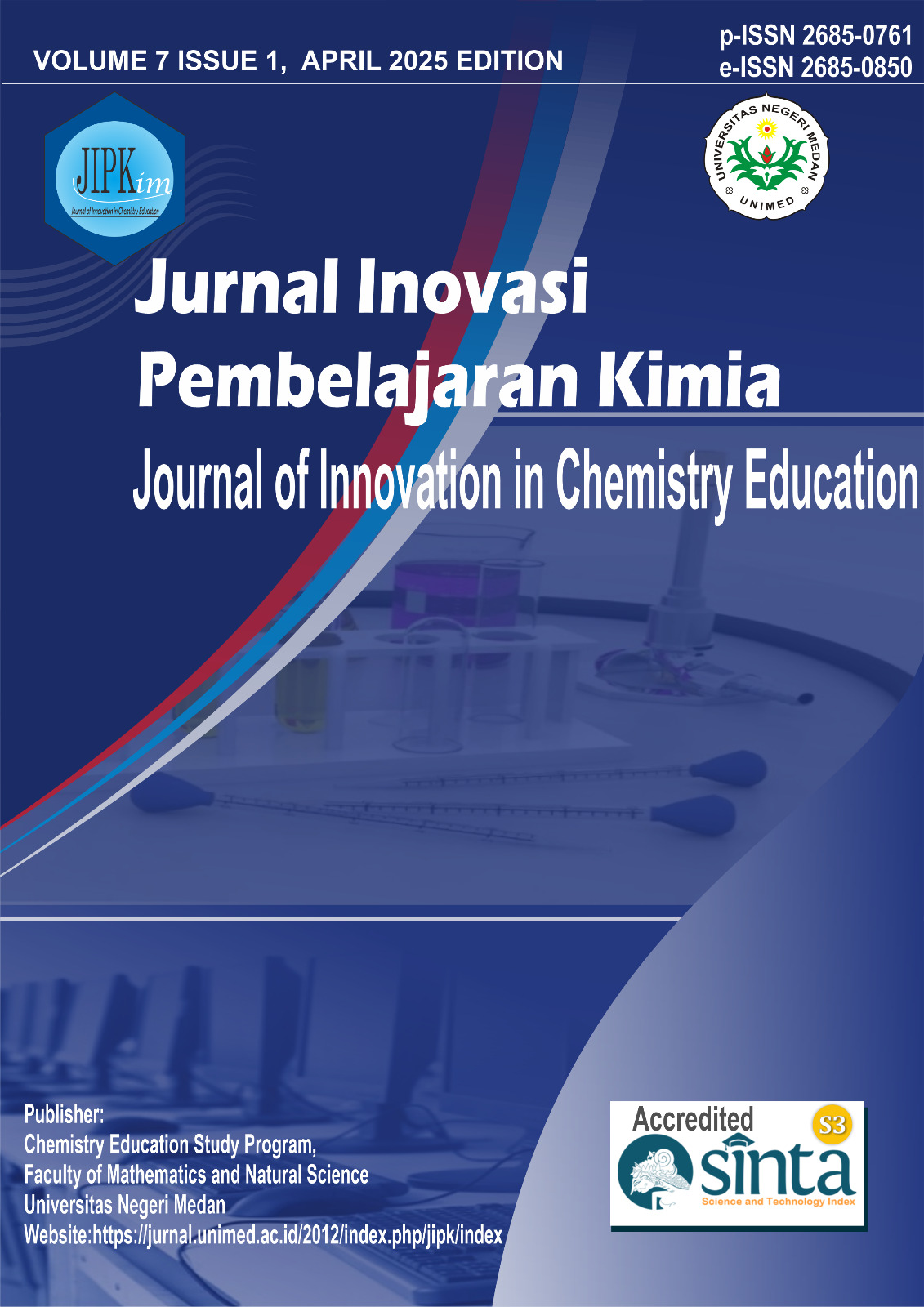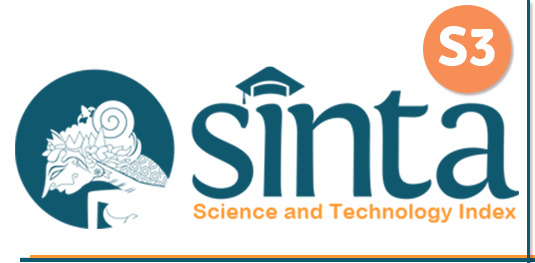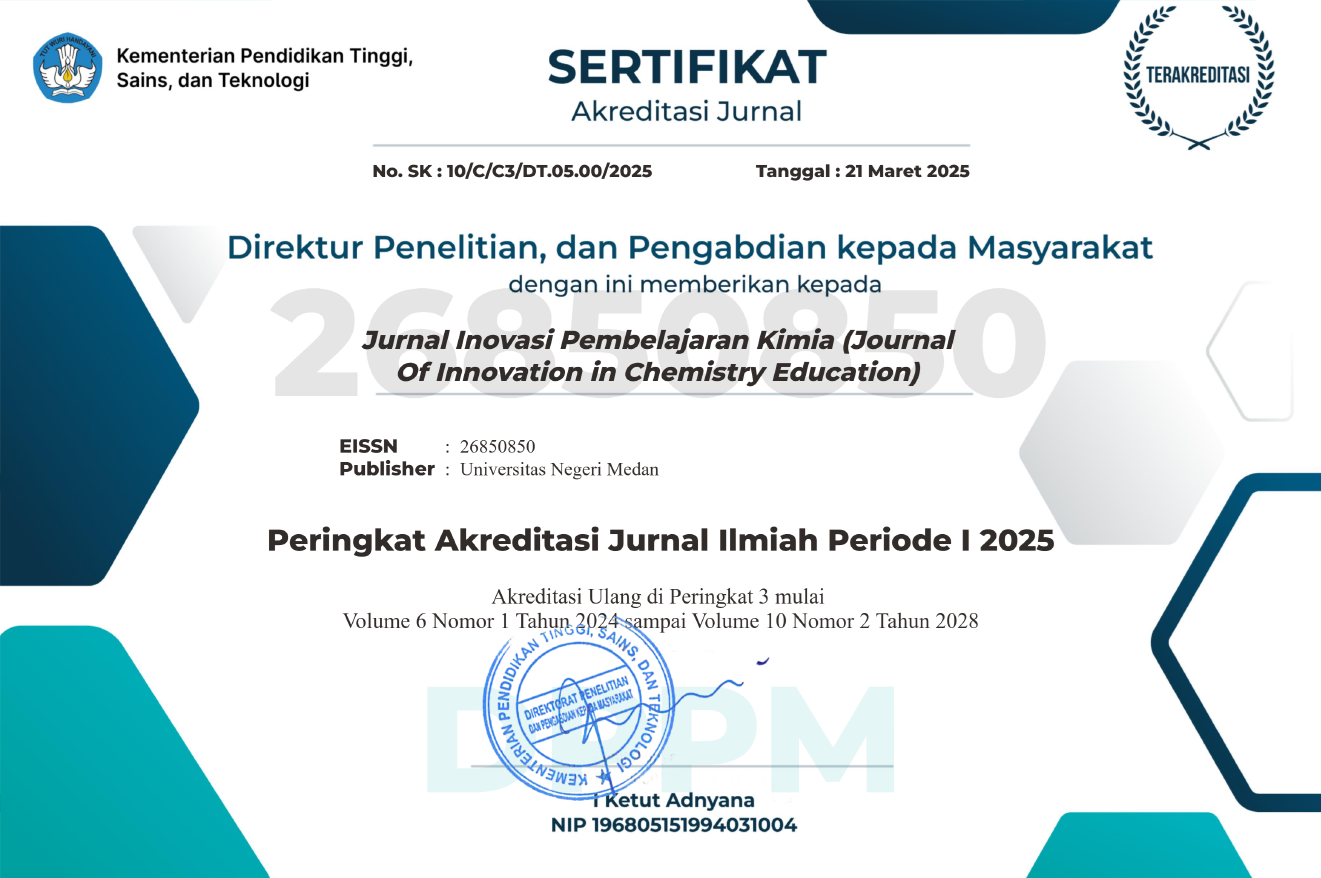Online Blended Learning Model to Improve Learning Independence and Learning Outcomes of High School Students
DOI:
https://doi.org/10.24114/jipk.v7i1.67604Keywords:
blended learning, learning independence, learning outcomes, online learningAbstract
The shift to online learning during the COVID-19 pandemic has challenged students’ ability to learn independently, highlighting the need for effective teaching models to support both autonomy and achievement. This study aims to evaluate the effectiveness of a blended learning model in improving learning independence and chemistry learning outcomes among XI-grade science students at SMA Zion. A classroom action research (CAR) design was employed over two cycles, each comprising planning, action, observation, and reflection phases. The intervention integrated synchronous (real-time online) and asynchronous (independent) learning activities. Thirty-four students participated. Learning independence was measured using a questionnaire, and learning outcomes were assessed through multiple-choice tests on hydrocarbon compounds. In Cycle I, students exhibited low learning independence (57.71%) and achievement (29.41% reached the minimum completion standard). Following targeted improvements such as learning journals, motivational strategies, and instructional videos in Cycle II, both indicators improved markedly: learning independence rose to 76.94%, and 82.35% of students met the minimum standard. The findings demonstrate that the blended learning model significantly enhances both learning independence and academic achievement, emphasizing the importance of innovative, adaptable pedagogical strategies in online education settings.References
Aini, K. (2021). Student Learning Independence Through Blended Learning Type Flipped Classroom During the COVID-19 Pandemic. Jurnal Literasi Digital, 1(1), 42–49. https://doi.org/https://doi.org/10.30605/jld.1.1.2021.7
Apsari, N., & Lestari, N. (2023). Acid Base Chemistry Module Based on Indigenous Knowledge during the Covid-19 Pandemic. Jurnal Pendidikan MIPA, 13(3), 775–783. https://doi.org/https://doi.org/10.37630/jpm.v13i3.1167
Ayuningsih, R. F., Andrianto, D., & Kurniawan, W. (2025). Integration of Blended Learning and Flipped Classroom Learning Models: An Effective Strategy in 21st Century Learning. Jurnal Inovasi Strategi Dan Model Pembelajaran, 5(1), 10–21.
Azah, N., & Abror, S. (2023). The Influence of the Flipped Classroom Type Blended Learning Model on Student Learning Independence. Cetta: Jurnal Ilmu Pendidikan, 6(1), 171–179.
Damanik, N., Riris, I. D., Sitorus, M., Sihombing, J. L., & Syafriani, D. (2024). The Effect of E-Module on Activity and Learning Outcomes on Electrolyte and Nonelectrolyte Solutions. Jurnal Inovasi Pembelajaran Kimia, 5(2), 174. https://doi.org/10.24114/JIPK.V5I2.54922
Fadilah, R. (2021). Efforts to Improve Learning Independence of ICT Guidance Through the Implementation of Edmodo-Based Blended Learning for Class IX-E Students of SMPN 1 Mejayan. Jurnal Literasi Digital, 1(3), 209–215. https://doi.org/https://doi.org/10.54065/jld.1.3.2021.21
Febriani, H., & Azizah, U. (2021). The Blended Learning Method Assisted by Google Classroom Increases Students’ Learning Independence. Jurnal Pendidikan Kimia Indonesia, 5(1), 9–15. https://doi.org/https://doi.org/10.23887/jpk.v5i1.31343
Fitria, Sukardi, & Handayani, N. (2023). The Effectiveness of Blended Learning Models and Learning Independence on Students’ Critical Thinking Skills. Jurnal Ilmiah Profesi Pendidikan, 8(1), 101–111. https://doi.org/https://doi.org/10.29303/jipp.v8i1.1159
Fitriani, L., & Rahimah, N. (2021). The Influence of Interest and Learning Independence on Student Learning Outcomes Using Google Classroom Media on Basic Material. In Prosiding Seminar Nasional MIPATI, 1(1), 1526.
Ginting, P., & Purba, J. (2024). The Influence of the Problem Based Learning Model on Student Interest and Learning Outcomes. Jurnal Inovasi Pembelajaran Kimia, 6(1), 46. https://doi.org/10.24114/JIPK.V6I1.57279
Gumilar, R., & Hermawan, Y. (2021). Improving Learning Independence Through e-Learning Methods. Jurnal Edukasi (Ekonomi, Pendidikan Dan Akuntansi), 9(1), 71–76.
Hafiza, M., Marlina, L., & Astuti, R. T. (2022). Development of Whiteboard Animation Learning Media on Hydrocarbon Material as an Alternative Media for Online Learning. Journal of Innovation in Chemistry Education, 4(1), 82–91. https://doi.org/10.24114/JIPK.V4I1.33661
Haka, N. B., Ellyandhani, L. A., Anggoro, B. S., & Hamid, A. (2020). The Influence of Blended Learning Assisted by Google Classroom on Students’ Creative Thinking Skills and Learning Independence. Edu Sains: Jurnal Pendidikan Sains Dan Matematika, 8(1), 1–12.
Hidayat, D. R., Rohaya, A., Nadine, F., & Ramadhan, H. (2020). Student Learning Independence in Online Learning During The COVID-19 Pandemic. Perspektif Ilmu Pendidikan, 34(2), 147–154. https://doi.org/http://doi.org/10.21009/PIP.342.9
Hidayati, K., & Listyani, E. (2010). Improving Instruments of Students Self-Regulated Learning. Jurnal Penelitian Dan Evaluasi Pendidikan, 4(1), 85–99.
Hikmah, A. N., & Chudzaifah, I. (2020). Blended Learning: A Post-COVID-19 Pandemic Learning Model Solution. Al-Fikr: Jurnal Pendidikan Islam, 6(2), 83–94.
Husni, R., & Nasution, W. R. (2023). Blended Learning: An Alternative Learning Strategy Post-Pandemic. Research Repository UIN Syekh Ali Hasan Ahmad Addary Padangsidimpuan. http://repo.uinsyahada.ac.id/id/eprint/1056
Islamy, W. F., Fatmariza, F., Ananda, A., & Montessori, M. (2022). Student Learning Independence in Online Lectures During the Covid-19 Pandemic. Journal of Education, Cultural and Politics, 2(2), 104–115. https://doi.org/https://doi.org/10.24036/jecco.v2i2.63
Ismaniati, C., Sungkono, S., & Wahyuningsih, D. (2015). Blended Learning Model To Increase Learning Independence and Attractiveness in Lectures. Jurnal Penelitian Ilmu Pendidikan, 8(2), 19–27.
Jabnabillah, F., & Margina, N. (2022). Pearson Correlation Analysis in Determining the Relationship Between Learning Motivation and Learning Independence in Online Learning. Jurnal Sintak, 1(1), 14–18.
Juliati, M., Salmiah, S., & Novita, Y. (2022). The Influence of Family Environment on Students’ Learning Difficulties in Economics Subjects at MAN 4 Pekanbaru School, Rumbai District, Pekanbaru City. Jurnal Pendidikan Ekonomi Dan Kewirausahaan, 5(1), 75. https://doi.org/10.24014/EKL.V5I1.1
Kurniawan, K., & Safri, J. (2019). Application of Blended Learning Model (Enriced-Virtual Model) to Improve Student Independence and Learning Achievement (Study on Indonesian Language Subject of Social Studies Program Students of Grade XI SMA Negeri 2 Lebong). Jurnal Ilmiah Teknologi Pendidikan, 9(1), 51–59.
Kusumasari, V., Chandra, T. D., Muksar, M., & Rahardi, R. (2022). Development of E-Modules Based on Problem Based Learning to Support Online Learning with Flipped Classroom. In PRISMA, Prosiding Seminar Nasional Matematika, 5, 195–201.
Loka, I. N., Sofia, B. F. D., Husnawati, H., & Anwar, Y. A. S. (2024). Identification of Student Learning Independence Level and Its Correlation with Learning Outcomes during Covid 19. Jurnal Ilmiah Profesi Pendidikan, 9(3), 2047–2055. https://doi.org/10.29303/jipp.v9i3.2455
Maesaroh, M., & Sutrisno, H. (2024). Distant Learning Satisfaction in High School Chemistry Amidst COVID-19 Pandemic: A Case Study. Journal of Innovation in Chemistry Education, 6(1), 162–169. https://doi.org/10.24114/JIPK.V6I1.57514
Mutaqinah, R., & Hidayatullah, T. (2020). Implementation of Online Learning (BDR Program) During the COVID-19 Pandemic in West Java Province. Jurnal Pendidikan Teknologi Informasi Dan Komunikasi, 6(2), 163–172.
Nurhamidah, N., Amida, N., & Elvia, R. (2022). Discovery Learning Model Based on Blended Learning to Improve Students’ Chemistry Learning Activities and Outcomes. Hydrogen: Jurnal Kependidikan Kimia, 10(1), 1–9. https://doi.org/https://doi.org/10.33394/hjkk.v10i1.4884
Pasaribu, L. H. (2021). Increasing Students’ Communication Skills and Independence Through Realistic Mathematics Learning Assisted by Google Classroom. Edumatica: Jurnal Pendidikan Matematika, 11(1), 42–49. https://doi.org/https://doi.org/10.22437/edumatica.v11i01.12373
Rahmawati, E., & Alaydrus, F. M. (2021). The Influence of Self-Regulated Learning on Critical Thinking Skills in Blended Learning. Jurnal Al-Hikmah, 9(1), 122–129.
Rofingah, S. (2021). Efforts to Improve Student Learning Outcomes in Mathematics Subjects with Limited Face-to-Face Learning through the Blended Learning Method during the Covid-19 Pandemic. EDUCATOR: Jurnal Inovasi Tenaga Pendidik Dan Kependidikan, 1(2), 168–173. https://doi.org/https://doi.org/10.51878/educator.v1i2.732
Sjukur, S. B. (2012). The Influence of Blended Learning on Learning Motivation and Learning Outcomes of Vocational High School Students. Jurnal Pendidikan Vokasi, 2(3), 368–378.
Sudana, I. W. (2021). Improving Student Motivation and Learning Outcomes Using The Blended Learning Method Through The Google Classroom Application. Indonesian Journal of Educational Development, 2(1), 38–47. https://doi.org/10.5281/zenodo.4781849
Sugita, R. D., & Muchlis, M. (2022). Implementation of Guided Inquiry Model Based on Blended Learning to Improve Student Learning Outcomes on Reaction Rate Material. PENDIPA Journal of Science Education, 6(2), 443–450.
Syelitiar, F., & Putra, A. (2021). Systematic Literature Review: Student Learning Independence in Online Learning. Sepren, 2(2), 23–31. https://doi.org/https://doi.org/10.36655/sepren.v2i2.490
Trisnawati, A. (2018). Students’ Self-Regulated Learning in STAD Cooperative Learning Combined with Blended Learning in the Chemistry Instrumentation Analysis Course. Jurnal Pijar Mipa, 13(1), 6–12. https://doi.org/10.29303/jpm.v13i1.409
Panggabean, F. T. M., Purba, J., & Sinaga, D. M. (2021). Development of Integrated Online Learning Media to Measure Students’ HOTS in Organic Chemistry Courses. Journal of Innovation in Chemistry Education, 3(1), 11–21. https://doi.org/10.24114/JIPK.V3I1.24298
Wahyudi, W., Jumadi, J., & Nurhidayah, D. A. (2022). Implementation of Student Learning Independence Instruments to Improve Learning Achievement During The COVID-19 Pandemic. Jurnal Cendekia: Jurnal Pendidikan Matematika, 6(1), 925–932.
Yuliati, Y., & Saputra, D. S. (2020). Membangun kemandirian belajar mahasiswa melalui Blended Learning di masa pandemi covid-19. Jurnal Elementaria Edukasia, 3(1), 142–149.
Yunsyahana, F., Auliah, A., & Djangi, M. J. (2022). The Effectiveness of the Discovery Learning Model on the Learning Outcomes of Class X Students of MAN Bantaeng. Journal of Innovation in Chemistry Education, 4(1), 92–100. https://doi.org/10.24114/JIPK.V4I1.33436













